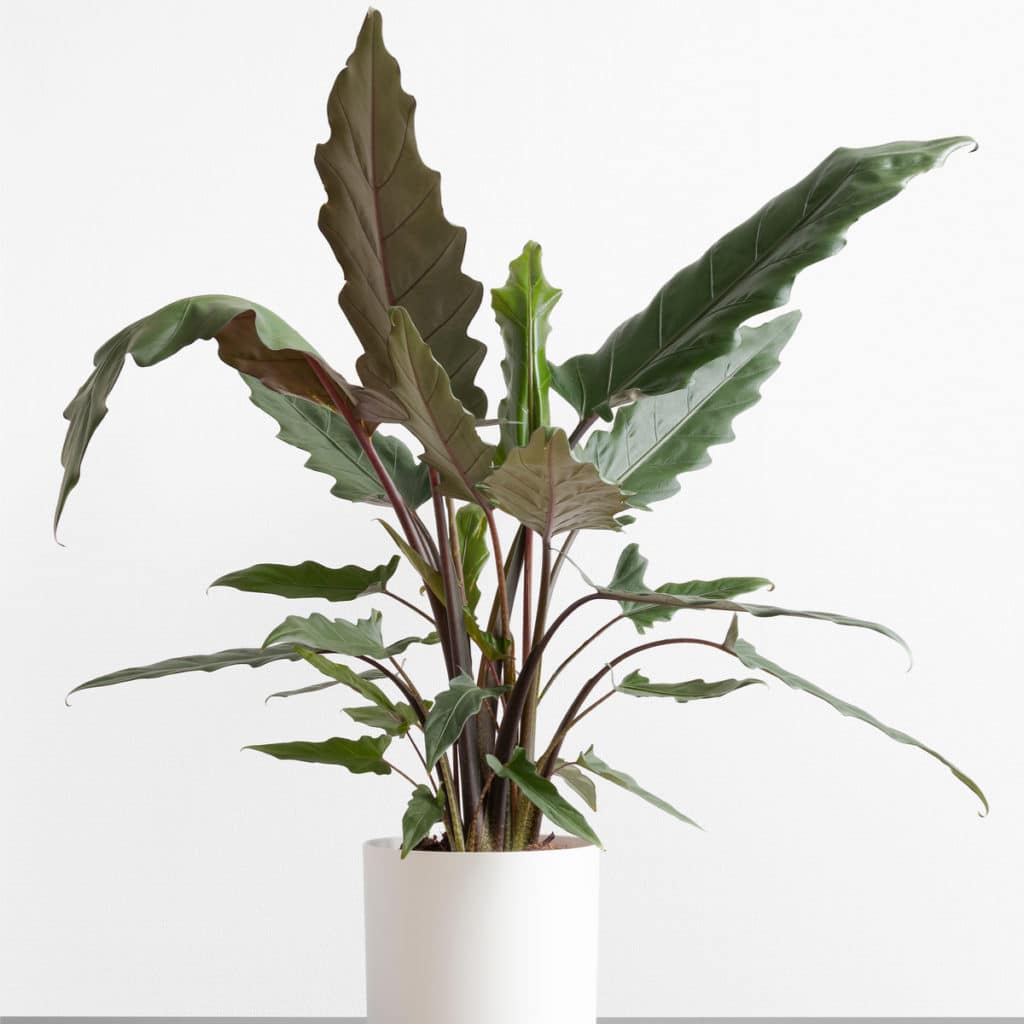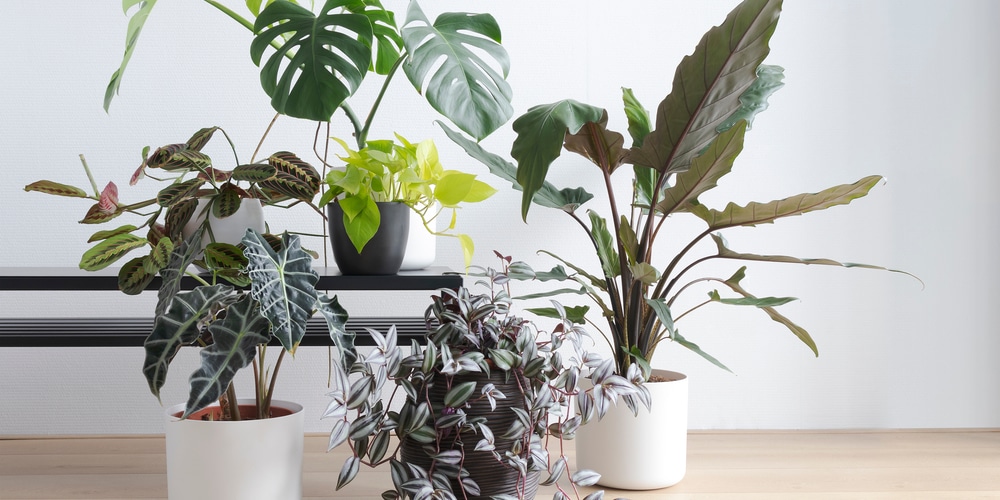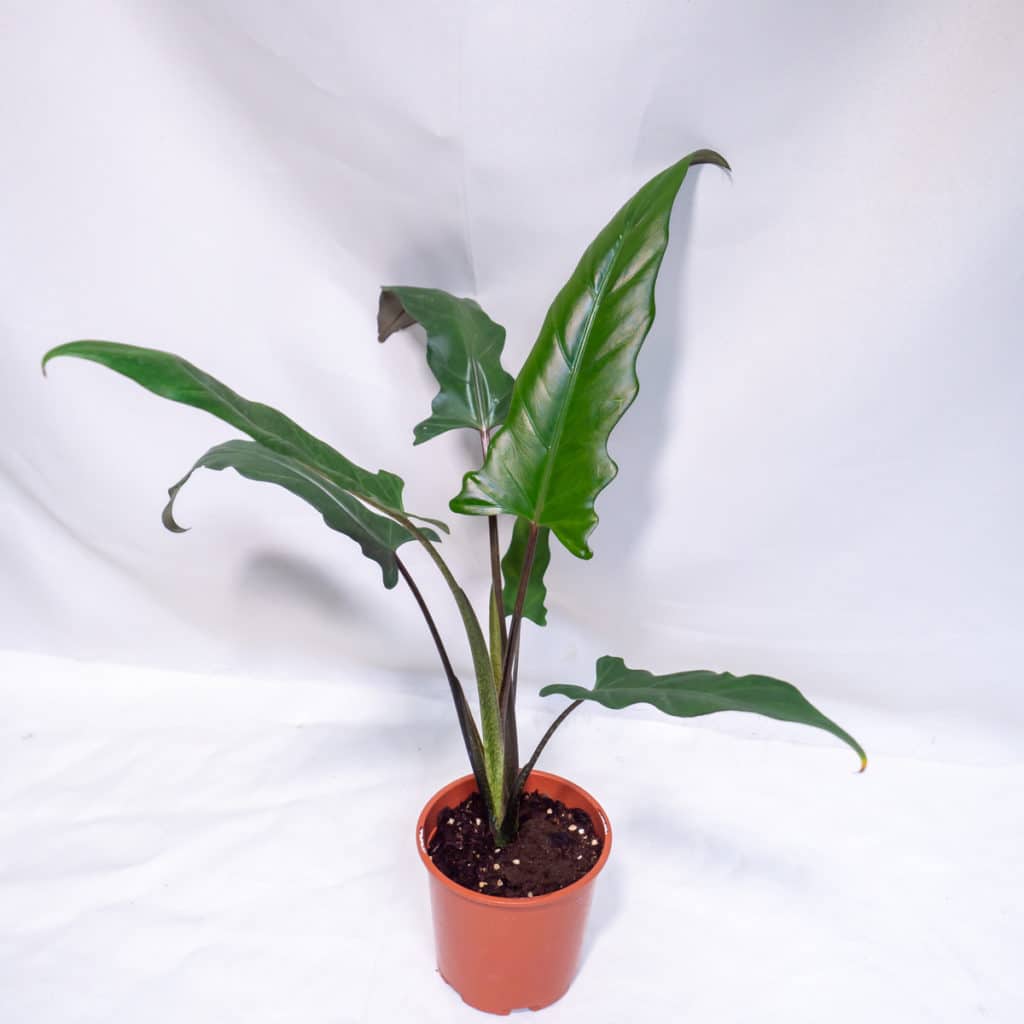Large tropical-looking plants are on trend at the moment as they help us bring nature inside our homes and perhaps remind us of a tropical vacation we had in the past. The Alocasia Lauterbachiana has beautiful deep green leaves with scalloped edges and purple undersides. They have sturdy stems and can grow up to three feet tall.
These attractive plants are fast-growing evergreens that are native to South East Asia. They have gained the nickname “purple sword plant” due to their large leaves with purple undersides. Let’s look at how to grow and care for an Alocasia Lauterbachiana plant.
What is a Alocasia Lauterbachiana?

The Alocasia Lauterbachiana or elephants ear plant has narrow-shaped leaves which look great as they have scalloped waved edges and raised purple veins. These attractive house plants grow in a unique way as their new leaves split from the stem. These plants are very fast-growing and often produce new leaves, especially during the growing season.
Providing your plant with extra water in the spring and summer months will help it thrive. You can even grow Alocasia Lauterbachiana outside in the right climate. When grown outside, these plants are likely to get taller and can grow up to four feet.
Alocasia’s have increased in popularity in recent years as they look great in modern homes with minimal décor. The Alocasia Lauterbachiana looks excellent and will make a stunning addition to any home or office.
The Alocasia Lauterbachiana is part of the Arum family, which has over seventy different varieties. These tropical plants grow well outside in warm, humid climates. They are also grown indoors globally. Some species of Alocasia can grow up to fifteen feet tall. These plants become dormant during the winter months to reduce the amount of energy they use. You can give your Alocasia Lauterbachiana less water during the winter.
How to Care for an Alocasia Lauterbachiana?
Alocasia Lauterbachiana are tropical plants that grow in the wild throughout Asia. They make excellent houseplants as long as they are cared for correctly. Here are some tips to help you care for your plant correctly:
Temperature
Alocasias are native to tropical climates, which means you’ll need to keep your plant warm. These plants do best in a warm and humid environment and can be grown outside if the climate is suitable. They are very sensitive to the cold, and if you’re keeping an Alocasia Lauterbachiana as a houseplant, you should ensure it’s not left in a draught from open windows or air conditioning. Aim to keep your home’s temperature between 18 and 22˚C so that your plant doesn’t get too cold.
Light
The Alocasia Lauterbachiana is a sun-loving plant that grows best in bright indirect sunlight. Being in the sun can help improve your plant’s color, but it shouldn’t be left in the full sun all day.
Watering
The Alocasia Lauterbachiana needs plenty of water in the spring and summer to help it grow new leaves. It’s best to water your plant with water that’s room temperature. Keep the soil moist by giving your plant small amounts of water regularly. Don’t overwater as plants that become waterlogged can suffer from root rot.
You can also give your plant an all-purpose fertilizer throughout the growing season. Don’t allow the soil to dry out completely. Your Alocasia Lauterbachiana will require less water in the winter when it’s dormant.
Soil
Alocasia Lauterbachiana should be kept in well-drained, light soil so that they don’t become waterlogged. You can add a layer of gravel or stones to the bottom of your plant pot to help with drainage. The soil must be able to retain moisture but should hold onto water and become soggy, or the plant’s health will be affected.
Toxicity
It’s worth noting that the Alocasia Lauterbachiana is a toxic plant. Children or pets who digest the plant’s leaves will suffer from mouth and throat pain, swelling and irritation.
Cleaning
The Alocasia Lauterbachiana should be kept clean and dust-free so that the plant can feed itself through a process known as photosynthesis. Wipe the plant’s leaves regularly using a damp cloth. It’s also a good idea to rotate your plant every now and again to encourage symmetrical growth.
Alocasia Lauterbachiana: Common Problems
Like all plants, the Alocasia Lauterbachiana is prone to developing some health problems and can be affected by pests. Here are some issues to look out for if you have an Alocasia Lauterbachiana:
Brown spots on the leaves
When brown spots begin to form on your plant’s leaves, you’ll need to make changes to its care or environment. Brown spots can indicate that your plant is living in a climate that isn’t warm enough or that it’s been burnt by the sun’s UV rays. They will also develop brown spots if they are left in a drought or are exposed to the cold. Carefully consider the cause of the problem and make changes to your plant’s environment.
Leaves Turning Yellow and Dropping Off
A common cause of yellowing leaves is either overwatering or underwatering. The Alocasia Lauterbachiana will drop its leaves as a survival tactic. You can feel your plant’s soil to see whether it has been over or under watered and then make alterations to the plants watering regime. Also, ensure your plant has good air circulation.
Spider Mites
Spider mites live in the soil and come out at night to feed on plants. They are particularly drawn to tropical plants such as Alocasia’s. Look out for grey discoloration on your plant’s leaves, as this indicates the presence of spider mites. Some Spider Mites can live without plants for up to a week, so once you get them, they can be a challenge to get rid of.
Conclusion
Alocasia Lauterbachiana are attractive tropical plants that are commonly kept indoors. They can also grow outside in the right environment. These plants look great as they have large dark green leaves are commonly called elephant ear plants.
Caring for these plants is relatively easy; they should be kept moist and given a general-purpose fertilizer throughout the growing season. Be careful not to leave your plant in a draught from an open window or air conditioning system.
They are fast-growing and can grow to three or four feet in the right conditions; they look great in a modern apartment. Alocasia Regal Shield is also a great choice for an apartment as well.

